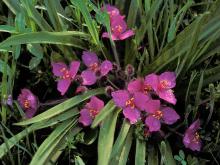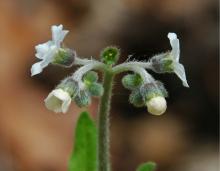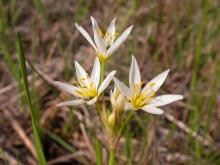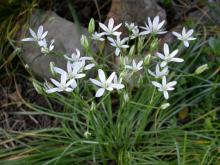Wildflowers, Grasses and Other Nonwoody Plants
Media

Species Types
Scientific Name
Calystegia sepium (also Convolvulus sepium)
Description
Instantly recognizable as a type of morning glory, hedge bindweed is common in disturbed habitats and can be a serious agricultural weed, but it is not as problematic as its relative field bindweed.
Media

Species Types
Scientific Name
Tradescantia longipes
Description
Dwarf spiderwort is a low-growing perennial with bright magenta, purple, or purplish-blue flowers with three petals arranged in a triangular pattern. It blooms in Ozark woodlands in April and May.
Media

Species Types
Scientific Name
Cynoglossum virginianum
Description
Wild comfrey has large basal leaves that are soft, hairy, and elliptical with long petioles — they look like hounds’ tongues! The upright flowering stalk has few leaves and looks like a wand.
Media

Species Types
Scientific Name
Anemone virginiana
Description
A member of the buttercup family, thimbleweed is named for the thimble-shaped dome of fruits that are densely packed at the center of the flower. Look for it blooming from late April through August in rocky or dry open woods and prairies.
Media

Species Types
Scientific Name
Gillenia stipulata
Description
Indian physic, or American ipecac, is a leafy plant that can cover entire hills in the Ozarks. Native Americans used it as an emetic for internal cleansing, a widespread ceremonial custom.
Media

Species Types
Scientific Name
Nothoscordum bivalve
Description
False garlic looks like a wild garlic or onion plant, but it doesn’t smell like one. The flowers can be white, yellowish, or greenish, and they appear in spring and sometimes also fall.
Media

Species Types
Scientific Name
Ornithogalum umbellatum
Description
Star of Bethlehem is an introduced exotic plant that makes clusters of bright white flowers in the spring. It reproduces prolifically by forming a multitude of bulbs underground.
Media

Species Types
Scientific Name
Cardamine concatenata (formerly Dentaria laciniata)
Description
Toothwort is a member of the mustard family that blooms March–May in wooded slopes and valleys. The sharply toothed, deeply lobed leaves are distinctive. The bright white, 4-petaled flowers shine at forest visitors.
Media

Species Types
Scientific Name
Micranthes virginiensis (syn. Saxifraga virginiensis)
Description
In Missouri, early saxifrage blooms February through June on rock outcroppings, ledges, glades, and bluffs. The flowers are at the tops of leafless stems. The fleshy, ovate leaves are in a basal rosette.
Media

Species Types
Scientific Name
Geum canadense
Description
White avens, a common wildflower in the rose family, may not catch your eye during hikes, but you will probably notice the seeds clinging to your socks when you get home!
See Also
About Wildflowers, Grasses and Other Nonwoody Plants in Missouri
A very simple way of thinking about the green world is to divide the vascular plants into two groups: woody and nonwoody (or herbaceous). But this is an artificial division; many plant families include some species that are woody and some that are not. The diversity of nonwoody vascular plants is staggering! Think of all the ferns, grasses, sedges, lilies, peas, sunflowers, nightshades, milkweeds, mustards, mints, and mallows — weeds and wildflowers — and many more!





















